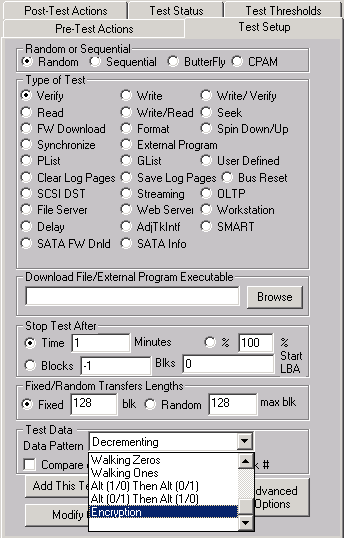In this Issue:
- Encrypted Data Pattern – Huge Performance Increase
- STB Suite Referral Program – Refer-A-Suite
- Ask Dr. SCSI – Fastest Write/Read test method?
- Reserve your live online meeting
New Encrypted Data Pattern showing big speed increase
 The “encryption data pattern” is the new data pattern contained in the Disk Manufacturing Module (DMM) of STBSuite. This pattern, as the name implies, contains completely encrypted data, so is completely random data. It is an alternative to the “random data pattern” when speed is of the essence. When data is being written to a drive, using the encrypted data pattern can produce as much as a 42% increase in performance over the random data pattern!!
The “encryption data pattern” is the new data pattern contained in the Disk Manufacturing Module (DMM) of STBSuite. This pattern, as the name implies, contains completely encrypted data, so is completely random data. It is an alternative to the “random data pattern” when speed is of the essence. When data is being written to a drive, using the encrypted data pattern can produce as much as a 42% increase in performance over the random data pattern!!
Here are some performance numbers that you may experience with the new encrypted data pattern:
Sequential Write with Random Data Pattern: 113 MB/s
Sequential Write with Encrypted Data Pattern: 168 MB/s (48% faster!)
Sequential Read with Random Data Pattern: 92 MB/s
Sequential Read with Encrypted Data Pattern: 152 MB/s (65% faster!)
To utilize the new encrypted data pattern, select the “Encryption” data pattern as shown in the picture below:

STB Suite Referral Promotion – Refer-A-Suite
STB Suite referral program
We’re proud to announce our Refer-A-Suite promotion.
As a Thank You to our valued customers we have launched a referral program for the STB Suite.
How to Qualify
- Referring party must be an Active Performa customer
- Fill out the online referral form (Provide potential customers contact information)
- Name
- The referred customer purchases a license within 30 days
- New referral’s only. Past orders are not eligible.
- You must comply with your company’s policies for gifts, etc.
Take your pick of Thank You gifts

You’ll receive your gift 30 days after the purchase is completed.
Ask Dr. SCSI – Fastest Write/Read test method?
 Q: “I want to test every block on disk drives to guarantee that each block can have data written to it and each block can then be read and the data checked. In other words, I want to write the entire drive and then read the entire drive with data compare.
Q: “I want to test every block on disk drives to guarantee that each block can have data written to it and each block can then be read and the data checked. In other words, I want to write the entire drive and then read the entire drive with data compare.
Is it faster to do a one-pass Write/Read test then it would be to do a two-pass Write then Read test? Wouldn’t one pass of the drive be twice as fast as two?
Signed – Mr. NeedsMoreTime”
A: “Dear Mr. N.. Actually, the answer is a resounding “No”, at least in the case of “normal” rotating magnetic disk drives. Here is an abbreviated example DMM log file entry, first showing the transfer rate and test time of a two-pass Write then Read test sequence, both run on a typical 400GB SAS drive:
06/19/2012 14:29:06 TEST 1 of 2:
Write Test; Sequential; for 879,097,968 Blocks
.
.
.
06/19/2012 15:13:57 Test Completed Successfully
Transfer Rate: 159.51 MB/sec
I/O Per Second: 2552.19 IO/sec
.
.
.
06/19/2012 15:13:58 TEST 2 of 2:
Read Test; Sequential; for 879,097,968 Blocks
.
.
.
06/19/2012 16:00:23 Test Completed Successfully
Transfer Rate: 154.13 MB/sec
Note that the total test time is just about an hour and a half, with the test sustaining a transfer rate of approximately 150 MB/second.
Now here is a DMM log file example of the same drive under test, this time doing a single-pass Write/Read test:
06/19/2012 16:00:23 TEST 3 of 3:
Write/Read Test; Sequential; for 879,097,968 Blocks
.
.
.
06/20/2012 02:53:25 Test Completed Successfully
Transfer Rate: 10.96 MB/sec
This single-pass test took about 13 hours to complete, with a sustained transfer rate of only 11 MB/second.
Why is the one-pass test so much slower than the two-passes?
It all has to do with keeping the data streaming to the drive with no interruptions. In the two-pass example Sequential Write test we are starting at the beginning of the drive, writing data, and smoothly incrementing through the disk’s blocks. This allows the drive’s cache to work in an ideal way, with the data stream virtually never being interrupted to wait for the drive to seek or reposition. Same thing for the sequential read step.
OTOH, the single-pass test causes the drive to move or seek in a jerky way. First it writes the first 128 blocks, then in order to read the same blocks we need to reposition back to the first block, waiting for the seek to finish, then do the read, then write, reposition, read, over and over. As the log file shows, all of this repositioning has a huge impact on the sustained data throughput rate.
The lesson here is “minimize disk repositioning whenever possible”.
The other lesson is “DMM log files contain very useful information”.
Reserve your live online meeting with the STB Suite team today
 Do you have questions about how to best use the STB Suite in your business? The STB Suite Team is happy to work with you in an interactive “live” environment to share with you about the STB Suite, testing procedures tailored to your needs, and much more. Use the online form here, or contact Sales today to get started.
Do you have questions about how to best use the STB Suite in your business? The STB Suite Team is happy to work with you in an interactive “live” environment to share with you about the STB Suite, testing procedures tailored to your needs, and much more. Use the online form here, or contact Sales today to get started.
